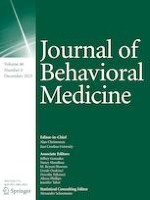Introduction
Methods
Participants
Procedures
Measures
Statistical approach
Results
Participant characteristics
Total Sample (n = 32)◊ | Weight/Shape Low Importance (n = 6) | Weight/Shape Pretty Important (n = 12) | Weight/Shape Very Important (n = 14) | p-value* | ||
|---|---|---|---|---|---|---|
Female, % (n) | 68.8% (22) | 83.3% (5) | 66.7% (8) | 64.3% (9) | 0.69 | |
Age, M (SD) | 54.50 (10.70) | 55.50 (9.27) | 52.75 (12.02) | 55.57 (10.54) | 0.78 | |
Baseline BMI, M (SD) | 38.37 (4.89) | 36.09 (3.37) | 38.73 (6.04) | 39.04 (4.35) | 0.46 | |
Race/Ethnicity | ||||||
White, % (n) | 75.0% (24) | 50.0% (3) | 75.0% (9) | 85.7% (12) | 0.14 | |
Black or African American, % (n) | 9.4% (3) | 33.3% (2) | 0% (0) | 7.1% (1) | ||
‘Other’, % (n) | 15.6% (5) | 16.7% (1) | 25.0% (3) | 7.1% (1) | ||
Hispanic or Latino, % (n) | 18.8% (6) | 16.7% (1) | 33.3% (4) | 7.1% (1) | 0.23 | |
Education | 0.67 | |||||
Less than bachelor’s degree, % (n) | 28.13% (9) | 33.3% (2) | 41.7% (5) | 14.3% (2) | ||
Bachelor’s degree or higher, % (n) | 71.87% (23) | 66.7% (4) | 58.3% (7) | 85.7% (12) | ||
Employment | 0.54 | |||||
Working full-time, % (n) | 50.0% (16) | 16.7% (1) | 58.3% (7) | 57.1% (8) | ||
Working part-time, % (n) | 43.75% (14) | 66.7% (4) | 41.7% (5) | 35.7% (5) | ||
Annual Income | 0.56 | |||||
<$50,000 per year, % (n) | 31.25% (10) | 66.7% (4) | 16.7% (2) | 28.6% (4) | ||
$50,000-$100,000 per year, % (n) | 18.75% (6) | 0% (0) | 16.7% (2) | 28.6% (4) | ||
>$100,000 per year, % (n) | 43.75% (14) | 33.3% (2) | 58.3% (7) | 35.7% (5) | ||
Prefer not to answer, % (n) | 6.25% (2) | 0% (0) | 8.3% (1) | 7.1% (1) |
Statistical Test | |||||
|---|---|---|---|---|---|
12-week Average, M(SD) | 24-week Average, M(SD) | WSCa | WSC x Timea | p-value of COVID-19 impactd | |
Percent Weight Lossb
(positive value= weight loss)
| 5.2 (3.8) | 6.5 (6.1) | Pretty Important: B = 0.01, SE = 0.03, p = .77 Very Important: B = 0.002, SE = 0.03, p = .95 | Pretty Important: B=-0.01, SE = 0.02, p = .75 Very Important: B=-0.01, SE = 0.02, p = .46 | 0.67 |
Weekly self-weighing frequencyc | 3.57 (2.56) | 2.89 (2.38) | Pretty Important: B = 2.49, SE = 0.89, p = .008** Very Important: B = 3.56, SE = 0.87, p < .001*** | Pretty Important: B=-0.05, SE = 0.04, p = .15 Very Important: B=-0.09, SE = 0.04, p = .01* | 0.43 |
Weekly dietary self-monitoring frequency | 5.73(2.25) | Pretty Important: B=-0.62, SE = 0.70, p = .38 Very Important: B=-0.13, SE = 0.69, p = .85 | Pretty Important: B = 0.11, SE = 0.08, p = .17 Very Important: B = 0.12, SE = 0.08, p = .12 | 0.001** | |
Daily caloric intakec | 1587.45 (378.54) | 1387.27 (386.59) | Pretty Important: B=-213.49, SE = 104.20, p = .050* Very Important: B=-161.82, SE = 104.17, p = .13 | Pretty Important: B = 28.43, SE = 10.14, p = .007** Very Important: B = 19.99, SE = 10.07, p = .051 | 0.19 |
Daily average MVPA minutesc | 54.55 (31.47) | 63.18 (35.33) | Pretty Important: B = 36.29, SE = 13.40, p = .01* Very Important: B = 15.43, SE = 13.09, p = .25 | Pretty Important: B=-0.14, SE = 0.27, p = .59 Very Important: B=-0.21, SE = 0.28, p = .45 | 0.06 |
